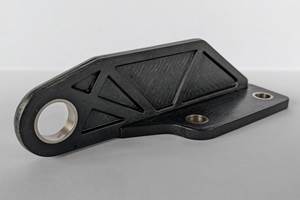University of South Alabama, MHP engage in research partnership for plastic composite material
ZT-CFRP, enriched with specifically oriented nanoparticles and reinforced with carbon fibers, shows considerable potential when compared to conventional CFRPs.

Dr. Sebastian Kirmse (left), involved in the composite material’s research, and Tobias Hoffmeister (right), president and CEO of MHP Americas Inc. Photo Credit: MHP
Professor Kuang-Ting Hsiao's group at the University of South Alabama (Atlanta) have recently developed ZT-CFRP, an innovative plastic composite enriched with nanoparticles and reinforced with carbon fibers which was originally supported by NASA. Funded by the U.S. National Science Foundation (NSF), the university has set up a research partnership in order to fully exploit the potential offered by the advanced composite material and to ensure that ZT-CFRP can be brought to a wider market swiftly.
In addition to the University of South Alabama, five companies from a range of sectors have been involved in the partnership, including MHP (Atlanta, Ga., U.S.), Porsche Motorsports (Calif., U.S.), UST Mamiya (Fort Worth, Texas, U.S.), Hexcel Corp. (Stamford, Conn., U.S.) and Toray Composite Materials America (Tacoma, Wash., U.S.). MHP will reportedly play a key role in this collaboration by working closely with the university to support the design of a roll-to-roll production process for ZT-CFRP, which will enable large quantities of the material to be produced at low cost. The project aims to bring ZT-CFRP to market by 2024.
“Our colleague, Dr. Sebastian Kirmse, wrote his dissertation at the University of South Alabama and, during this time, was involved in the research for this new, exciting composite,” explains Tobias Hoffmeister, president and CEO of MHP Americas Inc. “When Sebastian joined MHP in early 2020, he informed us about the new technology and got us involved. We were all convinced that the composite material had considerable potential, right from the outset.”
The plastic composite, which is enriched with specifically oriented nanoparticles and reinforced with carbon fibers, is said to have a number of properties that make it stand out from other composite materials in this group. Carbon nanofibers are threaded between the conventional carbon fibers in a zigzag formation, producing a fabric in which the mechanical, electrical and thermal loads are distributed in all directions within the composite, significantly increasing the material's conductivity (especially orthogonal to the fiber direction). The university notes that this means that ZT-CFRP is not only lighter than aluminum and tougher than steel it is also significantly less vulnerable to mechanical forces, such as impact damage, than conventional carbon fiber-reinforced plastics (CFRPs).
ZT-CFRP will be available both in the form of a prepreg roll and as a thin resin film that can be used to optimize traditional prepreg materials or to adhesively join two materials with improved mechanical, thermal and electrical connection and durability.
ZT-CFRP is also said to open up a wide range of potential applications, from automotive, to space, to sports like golf. “With cars, for example, we are constantly trying to guarantee a high level of safety for passengers, while at the same time, striving to reduce weight and thus energy consumption,” explains Dr. Sebastian Kirmse. “ZT-CFRP could replace aluminum as the material of choice for the chassis. This wasn’t possible with conventional carbon fiber-reinforced plastics, especially for parts exposed to increased thermal load.” The new composite could also be used in a similar way in spacecrafts. In addition, golf clubs are expected to become lighter and more powerful with the material. Dr. Sebastian Kirmse further states that, due to its multifunctional properties, the material entails an expanded spectrum of possible applications, which will be explored during the project in collaboration with the partners.
Related Content
The basics of composite drawing interpretation
Knowing the fundamentals for reading drawings — including master ply tables, ply definition diagrams and more — lays a foundation for proper composite design evaluation.
Read MoreOptimizing a thermoplastic composite helicopter door hinge
9T Labs used Additive Fusion Technology to iterate CFRTP designs, fully exploit continuous fiber printing and outperform stainless steel and black metal designs in failure load and weight.
Read MoreJeep all-composite roof receivers achieve steel performance at low mass
Ultrashort carbon fiber/PPA replaces steel on rooftop brackets to hold Jeep soft tops, hardtops.
Read MoreASCEND program update: Designing next-gen, high-rate auto and aerospace composites
GKN Aerospace, McLaren Automotive and U.K.-based partners share goals and progress aiming at high-rate, Industry 4.0-enabled, sustainable materials and processes.
Read MoreRead Next
CW’s 2024 Top Shops survey offers new approach to benchmarking
Respondents that complete the survey by April 30, 2024, have the chance to be recognized as an honoree.
Read MoreFrom the CW Archives: The tale of the thermoplastic cryotank
In 2006, guest columnist Bob Hartunian related the story of his efforts two decades prior, while at McDonnell Douglas, to develop a thermoplastic composite crytank for hydrogen storage. He learned a lot of lessons.
Read MoreComposites end markets: Energy (2024)
Composites are used widely in oil/gas, wind and other renewable energy applications. Despite market challenges, growth potential and innovation for composites continue.
Read More

















.jpg;maxWidth=300;quality=90)








